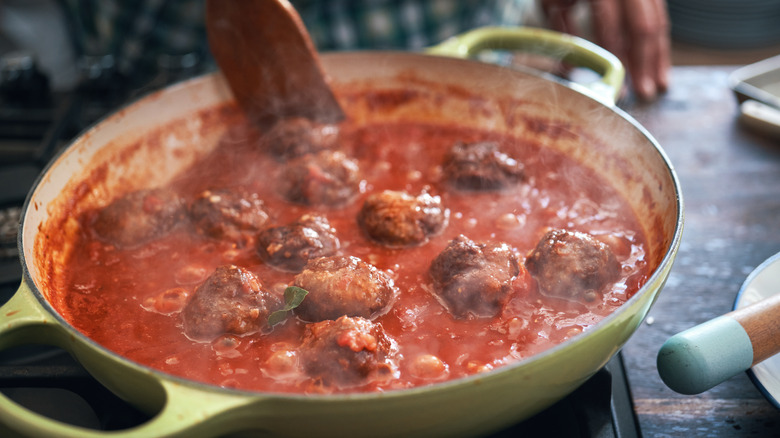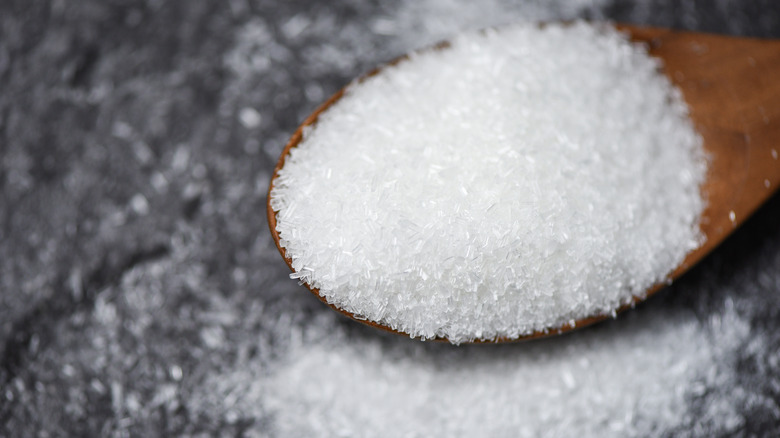Upgrade Lackluster Tomatoes With One Special Ingredient
We may receive a commission on purchases made from links.
We bet there's a bunch of fresh tomatoes sitting in your pantry right now and, somewhere in your meal plan, there's a recipe or two that calls for these bright red fruits. How could we not make that bet when they're so versatile? A single pot of all-purpose tomato sauce can be used for everything from dressing up pasta to simmering a fresh batch of spicy turkey chili. But not all tomatoes are created equally flavorful. If your tomatoes are tasting a little bit lackluster, try adding a pinch of monosodium glutamate. Sounds unfamiliar? Well, you'll know it by its initialism: MSG.
Yes, that's right — the same MSG that's often found in Asian recipes and savory snacks. Contrary to popular belief, MSG isn't just an artificial additive. It's a naturally occurring substance and a prime example of this is tomatoes. For every 100 grams of ripe tomato, there are about 250 milligrams of MSG within. Aside from amping up our perception of flavor, per the NPJ Science of Food Journal, MSG is also responsible for the production of a taste known as umami. It's a savory, almost meaty flavor that'll get your mouth watering.
This natural MSG plays a crucial role in how we perceive the fruit's taste and is why tomatoes are so delicious for us. So, as strange as it may sound, adding a touch of MSG when you're dealing with a bag of watery tomatoes lacking in flavor will make them taste as nature intended.
How to add MSG to your tomato dishes
A little really goes a long way with this seasoning. Because MSG tastes very intense, even though there's no real harm in doing so, we don't recommend adding it directly to your food. If you do, you'll run the risk of over-seasoning it, which will make the dish taste very salty. When that happens, there's no fix other than adding more food to balance it out or you'll have to scrap everything and start over.
That's why it's best to gradually season with MSG as you cook to control how much you're adding to the food. However, we run into a new problem here: aside from certain Asian recipes like fried rice where MSG is one of the must-have ingredients, there aren't many recipes that'll tell you to add MSG. Because of this, whenever you feel like incorporating MSG, you'll likely have to fly blind with no real measurement from the recipe sheet.
Fortunately, there's a rule of thumb that you can follow. For every six to seven servings of soups or casseroles that you're making, about 1 ½ teaspoons should suffice. For smaller portions, start with a quarter of a teaspoon, taste, and add more until the dish is to your liking. Not sure where to source some MSG? You can usually find it in the spice aisle at the supermarket (if you don't see plain MSG, look for the brand Ac'cent), or you can grab a shaker full from Amazon for $4.15.
Is adding MSG to tomatoes harmful?
Now that's the golden question. MSG hasn't enjoyed a good rep in the last few decades, so some people could be put off by this trick. But, if you recall, by eating a ripe tomato, you're already ingesting MSG. The powdered version that you find bagged up at the grocery store is no different from the MSG found naturally in tomatoes. It's just an isolated version, so a touch more to amp up the flavor shouldn't hurt.
The FDA states that MSG is an additive that's "generally recognized as safe", and that the vast majority of people will be able to consume MSG without experiencing any problems. In fact, when scientists conducted research into MSG allergies, they weren't able to identify any allergic reactions. As such, this condition has been dismissed as a myth.
You'd need to consume a lot of MSG all at once, about 3 grams, to even begin experiencing mild adverse symptoms. Unless you up-end an entire shaker of MSG into your food, you're not going to touch this threshold. But of course, good food is supposed to help you unwind and enjoy yourself, so don't feel too pressured to add MSG to your marinara sauce if it makes you nervous when you're about to tuck in. You can still season with extra salt and pepper to make up for the taste. And just in case you're curious, here's a list of the best salts to stock your pantry with to make your food taste amazing.


